continuousWave --> Whaler --> Reference
1981- 1990 Outrage 18
1991 Outrage 19
1992 Outrage 19 II
Dimensions & History
DIMENSIONS (from 1988 Catalogue listings unless otherwise noted)
Length......................18 feet 6 inches
Beam........................7 feet 2 inches
Draft.......................10 inches (with engine tilted clear of water)
Weight......................1250 pounds standard model Outrage 18
1900 pounds 19 Outrage II (1992)
Maximum Weight Capacity.....1925 pounds
1780 pounds 19 Outrage II (1992)
Swamped Capacity............3000 pounds
Persons Capacity............7 people
Maximum horsepower..........150 HP
Minimum Horsepower.......... 75 HP
Recommended Shaft Length.... 25-inch single engine; 20-inch dual engine
Fuel Capacity............... 63 gallon integral tank
in accessible central cavity
76 gallon integral tank,
not accessible, molded into hull (1992)
HISTORY
Designer....................Bob Dougherty
First year offered..........1981
Last year offered...........1992 (Hull still available from
Commercial Products Div.)
In 1991 the same model was renamed
the 19 Outrage. In 1992 with a re-designed
interior the same hull was marketed at the
19 Outrage (also known as 19 Outrage II)
Color.......................1981 - 1990 Desert Tan
1991 believed to be Desert Tan
1992 Whaler White
M.S.R.P.....................$ x,xxx in 19xx for Base boat
EQUIPMENT
Standard ................ Standard Console with teak access doors,
dash panel, locks, plexiglas windscreen,
stainless wheel, switch panel with 2 pre-wired
accessory switches, fuses and buss bar,
stainless rail, and twin-cable steering;
63-gallon fuel tank; Stainless bow rail;
two swivel seats; Recessed aft cleats with
hawsepipe; Rod racks; Pair of flush mounted
rod holders; Bow locker with fiberglass cover;
Teak gunwale boards; International navigation
lights; Fire extinguisher; Bow bitt; Lifting
eyes; Battery box with hold-down strap;
Heavy-duty rub rail.
Notable options...........Compass; Fire extinguisher pocket; Canvas,
including Bimini Top, Flying Top, Forward
Shelter, Windshield, Side Curtains, Mooring
Cover, Aft Curtain; additional Rod Holders;
Reversible Pilot Seat; Leaning Post.
Gunwale options...........In 1981-1985 the gunwales were capped with teak boards.
Beginning in 1986 all-laminated gunwales were
available as an option to the standard teak,
and required an up-charge of about $390.
In c.1989 the laminated/teak option flipped,
and the laminated gunwales became the standard
configuration. Until c.1991 teak gunwales were
offered as an option at an additional cost
(of about $300). In 1992 the teak option was
no longer available.
TRANSOM OPTIONS
Standard.................. 1981- 1991 notched transom with full-width transom
notch for twin outboard engines.
1992 notched transom for single engine only.
Sea Drive................. 1984 - 1987 Full transom with OMC Sea Drive
outboard engine mounted
Sea Drive Blank........... 1984 - 1987 Full transom without Sea Drive
to permit owner to attach aftermarket bracket
(Armstrong, etc.)
Gil Bracket............... 1985 - 1986 Full transom with outboard setback
bracket from Gil Manufacturing Co. of California.
Description
The Outrage 18 (1981-1990) is a true classic among the many models of Boston Whaler boats. Although only one foot longer than the 17-Montauk, the Outrage 18 is a much different boat in three important aspects: hull, cockpit, and fuel.
Hull
The hull of the Outrage 18 is a modified vee-hull shape that evolved from the original twin sponson designs of the earlier hulls. This vee-hull form evolved over the years, benefiting from several earlier iterations whose seakeeping was not as successful. The evolution proceeded along these lines: As the length and beam of the hull increased, the enormous lateral stability of the twin sponson design of the 13-foot hull was no longer a necessity; thus the central hull grew into a moderate vee-hull design, while the twin sponsons shrunk, becoming only vestigial runners. The hull shape retained the refined bow lines with the
classic "smirk" (formed by carrying the line of the runners up and across the bow). The resulting Outrage 18 hull was able to provide excellent lateral stability, but offered much improved ride in waves and chop compared with the 17-foot hull. The Outrage 18 was designed for operating in big waves and big water, to be able to go offshore and fish in the ocean.
For a boat to be successful for offshore fishing, it must be wide and stable enough to provide a platform that resists rolling uncomfortably while drifting or trolling, yet be capable of travelling at planning speeds through moderate waves without a harsh ride. The Outrage 18 met these requirements perfectly. Also, its hull form proved to be extremely stable in a following sea, a situation frequently encountered when running back to the harbor from ocean fishing. And a final plus, the hull was still relatively lightweight and easily planed, so good performance could be obtained without excessive horsepower on the transom.
Twin engines are often desireable on boats making long offshore runs, and
the transom notch of the Outrage 18 was designed to accomodate two outboards.
This was another significant step up from the smaller boats, whose
transoms were designed only for a single engine as the main power.
The Unibond hull of the OUTRAGE 18 contains embedded wood reinforcement material in various locations to allow attachement of screw fasteners and to strengthen the deck. These can be seen in a sketch that details the location and composition of the reinforcement.
Cockpit
The cockpit of the Outrage 18 is also slightly different from the smaller boats. There is more freeboard in the hull and thus there is a deeper cockpit.
The older, low profile "sled" hull design did not provide enough freeboard to keep large waves out of the cockpit, so the gunwales on the Outrage 18 are noticeably higher than those of the Montauk 17. This, again, reflects the offshore fishing heritage of the Outrage 18. The transom is provided with a large well (with drains) and the transom height kept low, so that water can drain quickly out the back should the boat be swamped. The design provides
sufficient reserve buoyancy that even in a swamped boat the outboard motor
powerhead will be above water, allowing the engine to run and to help
in draining water from the cockpit.
The inner liner (or "turtle") of the Outrage 18 is quite different
from the smaller boats. Generally, the smaller boats have interiors that
are one continuous molded floor, with a small sump in the stern and a
locker in the bow molded into them. The Outrage interior has several
cavities molded into it which are then sealed by either molded covers that are
mechanically fastened and caulked in place, or by hinged wooden (later molded) access covers. The fuel system, control wiring, hull drains, and sump pumps are
all located in these hidden cavities.
The cockpit featured the standard Whaler center console and offered
a choice of seating arrangements, principally either the standard twin swivel seats, optional teak Reversible Pilot Seat, or optional leaning post.
A full-width upholstered bench seat could be ordered to provide more seating in the stern. A cooler seat and bow cushions could augment seating forward of the console.
In 1992 the hull configuration was retained but a new liner was created,
intended for use with a third upper deck layer that now became the hull topsides
and deck. The new deck added a one-piece deck and console base, and enclosed a
portion of the transom at each corner, reducing the transom width so that only a
single engine could be mounted. A new, taller console was used with a tilt-forward design to gain access to wiring and rigging. The console also provided a large built-in electronics box in the upper portion of the console. The standard seating was two swivel seats mounted to a molded storage box in the deck. An optional leaning post was also available. The new deck molding did not have a removable section.
Fuel System
The Outrage 18 was one of the smallest boat to offer an integral fuel system.
(Later, integral fuel tanks were added to even smaller boats, such
as the Outrage 17 and Dauntless 16 models.) Most smaller Whalers carry their fuel in on-deck fuel tanks, but the Outrage 18 featured an integral aluminum tank, built into a hull cavity. This large fuel capacity (63-gallons) gave
the Outrage 18 the ability to make long trips without refueling. In comparison, the Montauk 17 would typically carry only 12-24 gallons of fuel, about a third of the Outrage's tankage. Carrying the fuel in a below deck, built-in tank gave the Outrage 18 a definite "big boat" feel; this was not just a little outboard runabout! The fuel system also provided tank vents, a fuel tank access with cap for filling located on the gunwale, fuel lines to the engine compartment, a fuel filter, and a fuel tank level gauge. This integral fuel system was a vast change from the smaller, open cockpit boats in the Whaler line.
The aluminum tank was mounted on rubber cushions and mechanically retained in the cavity. usually by an aluminum bar over the top of the tank (or by some arrangement of straps, possible aluminum). The tank was then foamed in place to prevent movement. In typical Whaler fashion, a unique arrangement of a clear access hole cover and a mechanical fuel gauge provided a very nice tank level indictor without using electrical gauges. The fuel tank was contained in a central hull cavity which was covered by a laminated/wood-reinforced deck that could be removed if necessary.
The fuel tank was fabricated by Florida Marine Tanks.
In 1992 the tank was increased to 76 gallons and was sealed into the interior of the hull as part of the redesigned interior of the boat. In the event repair or service on the fuel tank were needed, the center of the deck must be cut away to obtain access to the fuel tank. A step-by-step procedure was provided to guide repair.
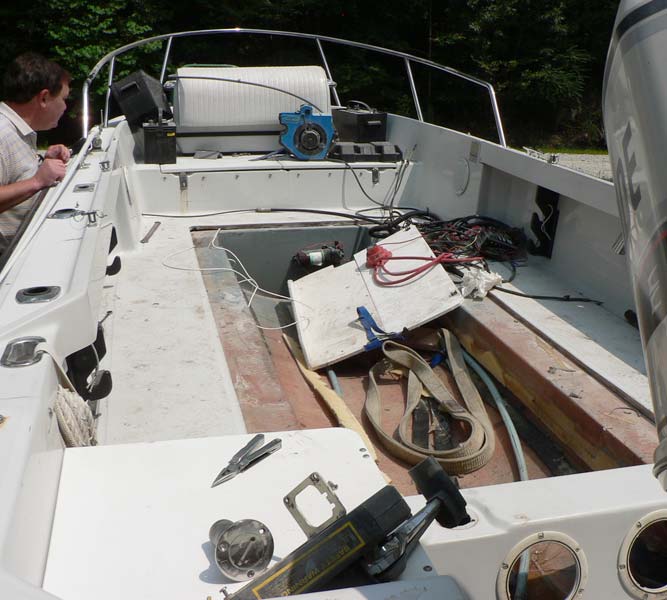
The three-skin construction of the later OUTRAGE 19-II boat is clearly seen here. The hull bottom and hull liner--the usual two-part Boston Whaler boat--are overlaid with a third piece, a cap. The hull liner is seen here as the dark gray and rose colored cavity for the fuel tank. The white deck lays atop the liner. The portion of the deck over the fuel tank cavity has been cut away. It appears that the forward area of the fuel tank cavity was not filled by the tank. A pump of some type appears mounted on the forward bulkhead of the fuel tank cavity.
Versatility
The Outrage 18 offered impressive offshore capability, yet it was small enough and light enough to be easily trailered. The boat's shallow draft made it useful inshore, too, adding to its versatility. Although an open boat, it could also be fitted with a complete package of canvas, turning it into a very comfortable foul-weather cabin. The large bow compartment could accomodate over night sleeping, especially under the cozy forward shelter canvas. The Outrage 18 was a boat that could do almost anything!
Model History
The Outrage model name has been associated with a number of different hull
designs in the course of Boston Whaler's boat building. The original "Outrages"
were the 19-foot and 21-foot hull mades from c.1970 until c.1978. Their hull form is quite different the Outrage 18. To add to the confusion, in 1990 the Outrage 18 was renamed the Outrage 19. The boat was then redesigned in 1991 and the hull color changed to white, becoming the 19-foot Outrage II. In 1996 a third model, the Outrage III, was introduced, and this variant was in production through at least 1998.
The 18-foot hull was also offered as a Newport style model in 1981-1984, as
the GTX model in 1982-1986 (photographs available in CETACEA), and as a Striper model (without built-in fuel tank) in 1981. A limited number of MONTAUK 18 models were built using this hull form, too.
Commercial Products Division
Models of the 18-foot hull were also available from CPD in various configurations and trim.
Photographs
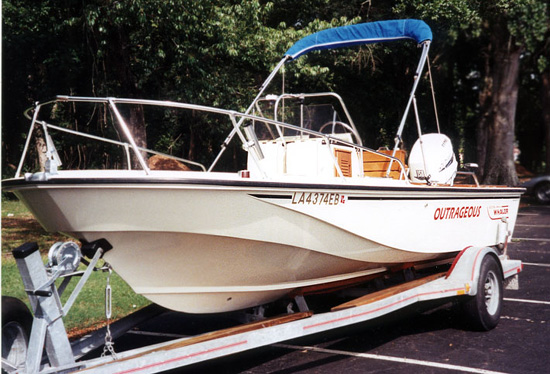 |
1986 Boston Whaler Outrage 18
The Outrage 18 is seaworthy enough for the ocean, yet
small enough to be transported on a single axle trailer.
Twenty-five years of evolution produced this intriguing hull shape.
This is also a nice example of trailer rigging, including
a 12-inch wide added wooden walkway.
PhotoCredit: David Reid. Scan: JWH |
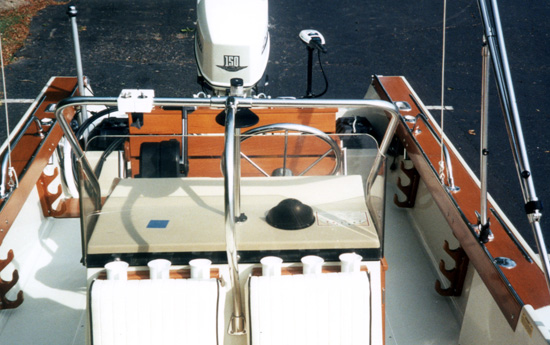 |
1986 Boston Whaler Outrage 18 Cockpit
There are many details shown in this view of the cockpit of the Outrage 18.
Note the light shield on the white masthead light.
Seating is the optional Reversible Pilot Seat. The vinyl
was recently redone by Dave's Upholstery.
The transom and motor well are full width, and they are low
enough to allow a swamped boat to quickly shed water.
PhotoCredit: David Reid. Scan: JWH |
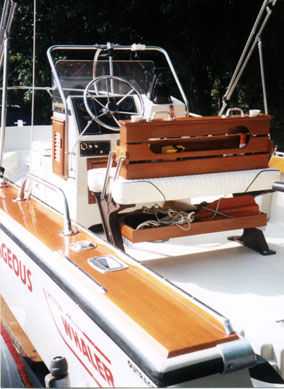 |
Classic Cockpit
Teak gunwale caps add a beautiful yachty look to this classic.
Note the strong rub rail hardware. Everything looks very
purpose-built, not merely decorative. That is the heart of
classic Boston Whaler boat design. The under-seat shelf
was added by a previous owner.
The gunwale teak is finished with Sikkens satin, then buffed out to
a near-gloss finish.
PhotoCredit: David Reid. Scan: JWH |
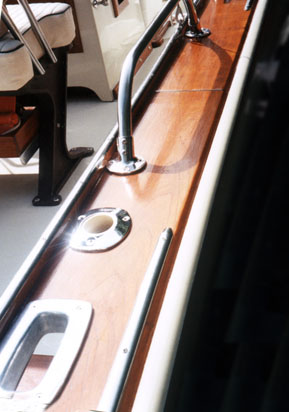 |
Gunwale Details
Extremely high quality hardware is used in the Outrage,
applied with the utmost detail.
Notice how the wooden gunwale is capped with an stainless steel strip to
prevent wear. A similar chafing strip protects the gunwale from
mooring lines coming from the hawsepipe.
Of course the oversized cleats are below deck, where
they won't snag any fishing lines.
The stainless steel grab rails are secured with stainless steel rivets.
The Lee's rod holders are the highest quality available. Small details and
fine engineering like this are what make the Whaler so attractive.
Remember, you are looking at a boat that is 15-years old and
used in salt water! Using the best pays dividends in the long run.
PhotoCredit: David Reid. Scan: JWH |
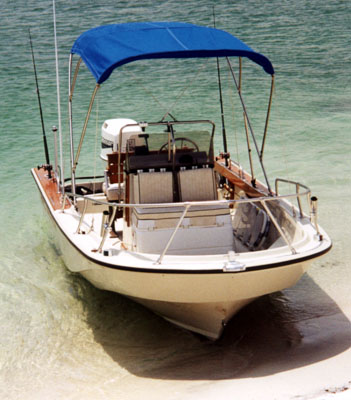 |
Ocean Bred
Capable of handling offshore ocean fishing, the Outrage 18
needs only 10 inches of water to float. She can easily be beached.
The Sun Top is from Mills Canvas, and it is
the original that came with the boat 15 years ago.
PhotoCredit: David Reid. Scan: JWH |
Owner Testimonials
Owner experiences and testimonials will appear in a separate article.
In the meantime, I invite you to read my own experiences with a classic Outrage-18 and the later 19-foot Outrage-II.
To Larry Goltz, who
has provided me with a wealth of historical documents on this model,
and to David Reid, whose fine Outrage and photographs appear here, I must
extend my most sincere thanks. And to Tom Clark, thanks for the several corrections you suggested.
continuousWave --> Whaler --> Reference
DISCLAIMER: This information is believed to be accurate but there is no
guarantee. We do our best!
The page has been accessed times.
This article first appeared February 11, 2001.
Copyright © 2001 by James W. Hebert. All rights reserved.
Unauthorized reproduction prohibited.
This is a verified HTML 4.0 document served to you from continuousWave
URI: http://continuouswave.com
Last modified:
Author: James W. Hebert





